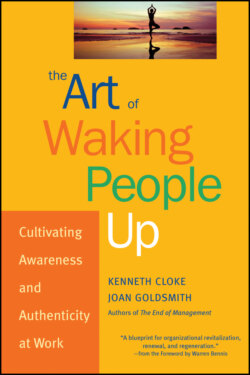Читать книгу The Art of Waking People Up - Kenneth Cloke - Страница 46
Breaking the Cycle of Distrust
ОглавлениеThe foundation of all turnaround processes and techniques is trust. There will always be incidents that take people to the edge of their willingness and ability to trust each other. Those who deliver turnaround feedback, coaching, mentoring, and assessment need to build trust by being open and honest enough to relay information that is difficult to hear and empathetic enough to listen and learn. Those who receive it build trust by being willing to translate what they learn into committed action.
Once either side slips into distrust, a self-reinforcing downward spiral begins that seems impossible to escape. Whatever recommendation either side offers for reducing the distrust rings false to the other side. Distrust then feeds on distrust, creating a circular dynamic in which unmet expectations lead to distrust, which triggers self-protecting, trust-breaking behaviors in response. Each side views the other side’s behaviors as hostile or disrespectful and adopts a self-protective stance that causes further distrust, as illustrated in Figure 2.1.
Figure 2.1 Cycle of Distrust.
In this way, distrust becomes a vicious circle from which it seems impossible to escape. Yet turnaround processes and techniques create multiple turning points and openings through which trust can be regained. When we examine these turning points and openings closely, we discover a rich variety of methods for rebuilding trust in relationships. It is possible, for example, to rebuild trust by the following measures:
• Negotiating clear boundaries and respecting those created by others, whether or not they respect yours
• Speaking honestly and intimately about yourself and your mistakes
• Being as sincere and unlimited with apologies as you are with honest feedback
• Being consistent over time
• Being open about problems and flexible about solutions
• Empowering others to make decisions or making them collaboratively
• Jointly agreeing on a vision or shared values or goals for your relationship
• Making your actions congruous with your vision, values, and words
• Encouraging teamwork, collaboration, and participation
• Listening and empathizing with others even if they have not listened or empathized with you
• Being dependable in crises or hard times
• Participating in social interactions and sharing personal information about your life
• Offering to sacrifice something important to you to achieve a larger goal
• Treating everyone with unconditional respect
Trust is a choice in every relationship. None of these actions will guarantee the restoration of broken trust, but they will make it more difficult to maintain distrust and gradually diminish trust-breaking behavior. Residue from past experiences, fears about the future, and incongruent behaviors in the present fuel feelings of distrust and block successful feedback, coaching, mentoring, and assessments, spinning employees into a downward spiral of anger and pain. Trust is rebuilt by focusing not on what the other person did or did not do but on critiquing one’s own behavior, improving one’s trustworthiness, and focusing attention not on words and promises but on actions, attitudes, and ways of being.
